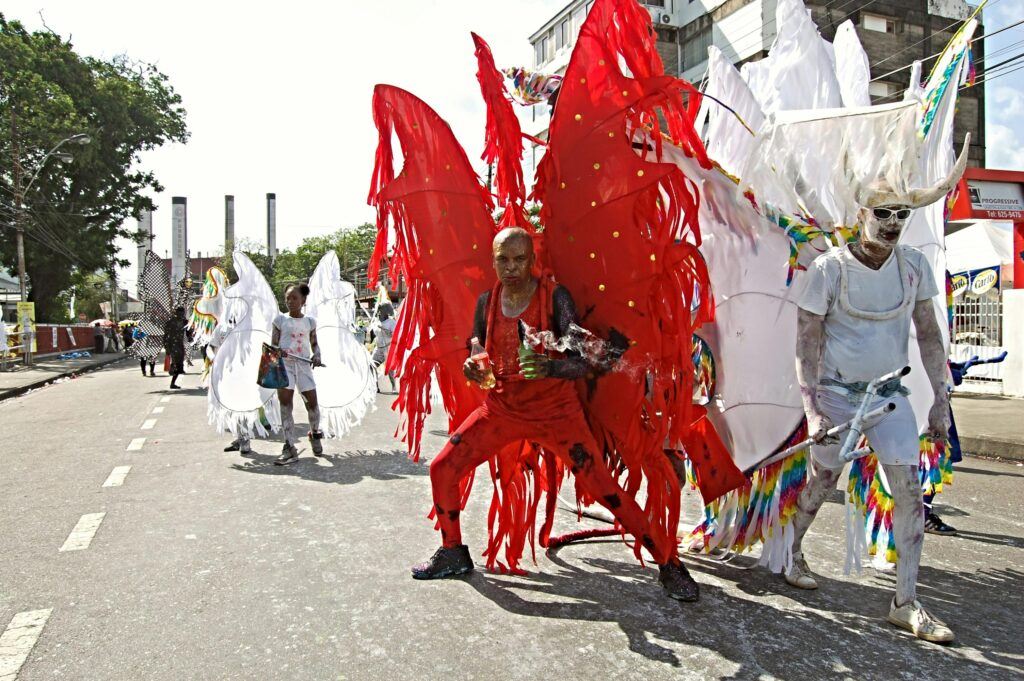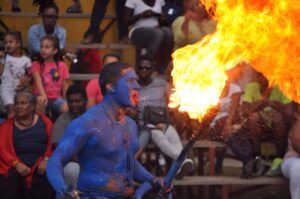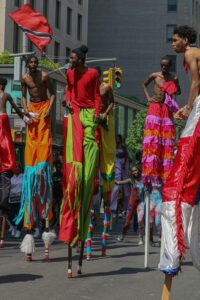
Trinidad and Tobago’s carnival offers more than just spectacle; it represents a rich tapestry of cultural expression where music, dance, and art unite. There’s a deeper essence present in the traditional ‘Mas’ characters that roam the streets every year.
In these characters, often vibrant and full of life, lies the heartbeat of Trinbagonian culture. Each costume carries a story, a slice of history that connects past struggles and triumphs to present-day celebrations.
The development of Mas has not been in isolation. It’s an intricate dance between history and culture, each step molded by the diverse influences of African, Indigenous, and European traditions. This melding of cultures created something unique that continues to thrive.
As you journey through these traditions, you’ll find that understanding Mas is crucial to grasping the spirit of Trinidad and Tobago’s carnival. It’s about appreciation and recognition of a legacy passed down through generations, immortalized in every feather and sequin.
Origins and Evolution of Iconic Mas Characters
 Tracing the roots of traditional Mas characters is like following a map marked by the footsteps of history. You start to see a blend of African, Indigenous, and European influences shaping the vibrant chaos seen in today’s carnival. Each culture brought its own set of practices and beliefs, which melded together to form the unique tapestry of Trinidad and Tobago’s cultural expression.
Tracing the roots of traditional Mas characters is like following a map marked by the footsteps of history. You start to see a blend of African, Indigenous, and European influences shaping the vibrant chaos seen in today’s carnival. Each culture brought its own set of practices and beliefs, which melded together to form the unique tapestry of Trinidad and Tobago’s cultural expression.
Traditional Mas didn’t just appear overnight. It evolved over centuries, adapting and transforming with each passing generation. Originally rooted in the celebrations of freed slaves, these characters became vivid manifestations of cultural identity and freedom. Over time, as the carnival scene grew, so did the creativity and complexity behind each costume and character portrayal.
Today, authenticity mingles with innovation. Mas enthusiasts maintain traditional roots while embracing new styles and materials. This balance between old and new is key to preserving cultural richness while keeping the carnival dynamic and relevant.
To truly appreciate the evolution of these Mas characters, it’s essential to respect their origins while observing how they’ve adapted to reflect current societal issues and trends. This evolution is a testament to the resilience and creativity of Trinbagonians, who have continued to breathe life into history through their carnival celebrations.
Significant Traditional Mas Characters and Their Stories
In the world of Trinidad and Tobago’s carnival, a few traditional Mas characters stand out, each carrying a narrative rich with cultural symbolism and historical depth. These figures aren’t mere entertainers; they embody the vivid storytelling at the heart of carnival.
The Pierrot Grenade, known for his sharp wit and eloquence, offers satire and intellect, highlighting issues in society through clever speech. This character uses humor as a powerful tool, blending entertainment with a thought-provoking message.
Then there’s the Midnight Robber, a fusion of fearlessness and creativity. With his elaborate costumes and bombastic speeches, he tells tales of power and revenge, often reflecting historical figures and themes. Each performance is an immersive experience in storytelling, leaving a lasting impression on the audience.
The Moko Jumbie adds a supernatural touch, towering above the crowd on stilts, offering protection and spiritual connection. Originally, this character was seen as a guardian, a figure that bridged the earthly and the spiritual. Today, the Moko Jumbie continues to captivate audiences with its graceful movements and symbolic presence.
protection and spiritual connection. Originally, this character was seen as a guardian, a figure that bridged the earthly and the spiritual. Today, the Moko Jumbie continues to captivate audiences with its graceful movements and symbolic presence.
The Blue Devils represent rebellion and chaos, their menacing looks serve as a reminder of the carnival’s roots in challenging societal norms. Their presence exemplifies the carnival’s embrace of freedom and expression, allowing participants to confront fears and societal constraints openly.
Preserving Tradition in a Modern Carnival Era
In today’s world, where change is constant, maintaining the essence of traditional Mas characters in Trinidad and Tobago’s carnival poses its own set of challenges. Balancing these time-honored customs with modern innovations isn’t just about preserving the past; it’s about ensuring the continuity of cultural identity.
A key element is community involvement. By engaging local communities in crafting costumes and stories, a living link between generations is forged. Cultural education plays a pivotal role here, passing knowledge and skills from seasoned performers to new generations eager to learn.
At the same time, authenticity must be protected even as globalization influences styles and materials. Striking this balance involves honoring the core attributes of traditional Mas while allowing for creative expression that resonates with today’s audience.
Embracing change while staying true to cultural roots requires thoughtful adaptation. It’s a delicate dance that ensures the spirit of Mas remains vibrant and relevant, continuing to inspire and empower people across the globe. Through this approach, Trinidad and Tobago’s carnival not only celebrates its traditions but also evolves, keeping the legacy alive and thriving.
Hi there I am 15 years old and Currently I’m doing my English A SBA and I would like to use this same article and CXC is asking me for the date it was published. If this is not an issue I would l gladly use this piece. I truly adore it.
admin
Good afternoon Mia. We are honoured by your appreciation of our work. This article was published on November 24th 2024. Please feel free to use the piece for your exams and also feel free to share it with those who you believe would appreciate the content.